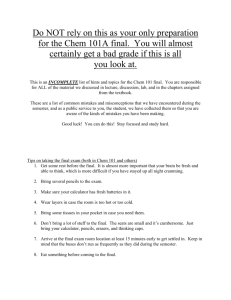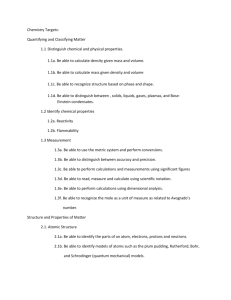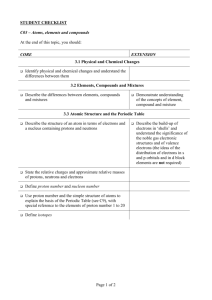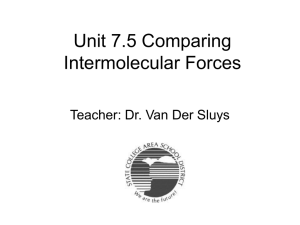Tips in preparing for the Chem 101 final exam:
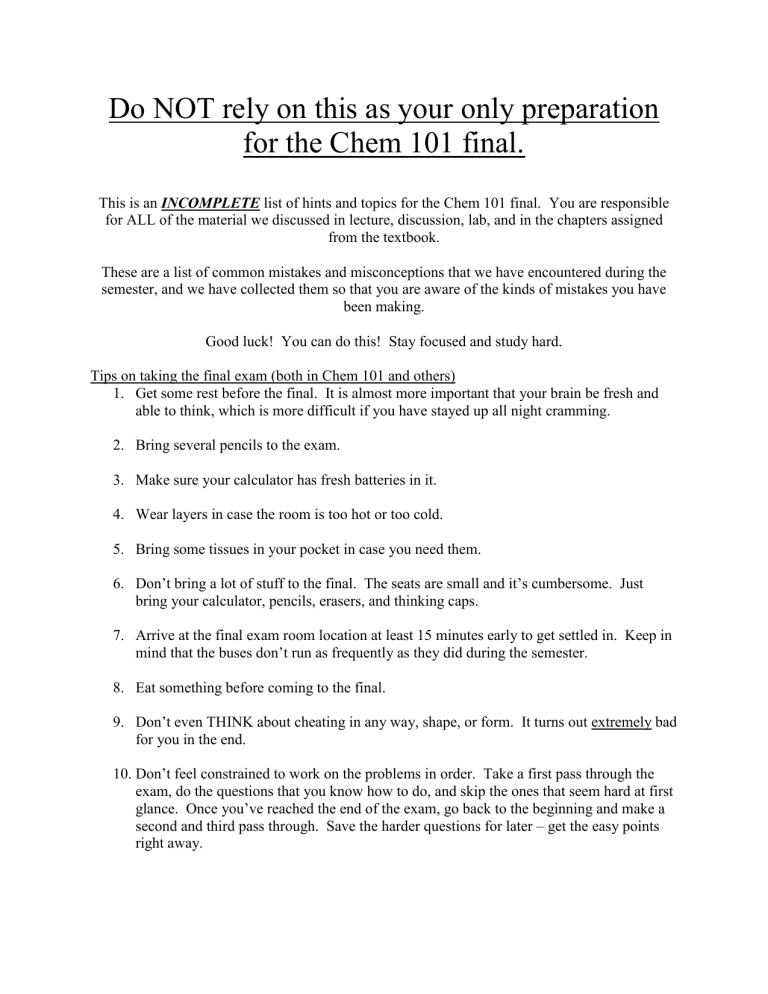
Do NOT rely on this as your only preparation for the Chem 101 final.
This is an INCOMPLETE list of hints and topics for the Chem 101 final. You are responsible for ALL of the material we discussed in lecture, discussion, lab, and in the chapters assigned from the textbook.
These are a list of common mistakes and misconceptions that we have encountered during the semester, and we have collected them so that you are aware of the kinds of mistakes you have been making.
Good luck! You can do this! Stay focused and study hard.
Tips on taking the final exam (both in Chem 101 and others)
1.
Get some rest before the final. It is almost more important that your brain be fresh and able to think, which is more difficult if you have stayed up all night cramming.
2.
Bring several pencils to the exam.
3.
Make sure your calculator has fresh batteries in it.
4.
Wear layers in case the room is too hot or too cold.
5.
Bring some tissues in your pocket in case you need them.
6.
Don’t bring a lot of stuff to the final. The seats are small and it’s cumbersome. Just bring your calculator, pencils, erasers, and thinking caps.
7.
Arrive at the final exam room location at least 15 minutes early to get settled in. Keep in mind that the buses don’t run as frequently as they did during the semester.
8.
Eat something before coming to the final.
9.
Don’t even THINK about cheating in any way, shape, or form. It turns out extremely bad for you in the end.
10.
Don’t feel constrained to work on the problems in order. Take a first pass through the exam, do the questions that you know how to do, and skip the ones that seem hard at first glance. Once you’ve reached the end of the exam, go back to the beginning and make a second and third pass through. Save the harder questions for later – get the easy points right away.
11.
Do NOT fill in the scantron as you go. Fill in the scantron towards the end of the exam, especially if you are skipping between questions. This will help prevent you from bubbling answers incorrectly on the form – remember that the only answer that counts is what you mark on the scantron form.
12.
Make sure you clearly mark what answer you intend to pick in your test booklet so you can enter them on the scantron later.
13.
Ask questions if you are unclear of what the question is asking or if you are having trouble interpreting the questions. The worst that can happen is that the TA tells you that they cannot give you any additional information.
14.
Don’t be afraid to take a moment during the exam, close your exam booklet, and let your brain unwind a little bit. Remember, we expect you to be able to apply what you learned.
15.
Don’t fall asleep during the final. See #1.
16.
THINK about what you want to do, then do it. In that order.
Tips in preparing for the Chem 101 final exam:
Review the old hour exams and use them to fine tune your studying. Don’t waste time studying things you already know and understand – use that time to hit the topics that you are struggling with.
Don’t avoid topics you aren’t comfortable with – that’s the entire point of studying.
These are the things that you should focus your studying on. If you don’t understand something, ask someone for help! If you don’t understand it after they explain it to you, ask them to do it again! You may feel embarrassed, but it’s much better to actually know what’s going on then to pretend like you do just so you don’t look silly.
If your math skills are weak, now is the time to fix that. If you can’t do the math efficiently , you will struggle on the final exam. Practice makes perfect, especially with math, so work on those unit conversions, making sure that everything cancels out correctly.
Look over the lab reports and on-line homework problems! You spent a lot of time working on them, and coincidentally, a lot of the hour exam questions are similar to what you’ve seen on your lab reports and on-line homework. You had to do a lot of explaining in the labs, and you can be sure that there will be explanation questions on the final.
Understand WHAT you are doing and WHY you are doing it! Don’t just memorize how to do the hour exam problems! I will guarantee that you won’t see those questions again!
You will see some questions that are similar to them, and you will see new questions that you haven’t seen before! If all you know how to do is follow a bunch of steps, then you
are going to have a long 3 hour exam period. You need to understand why you are doing each calculation (How are you going to use the results of that calculation to get to the answer? Just because you can calculate something doesn’t mean that you should!).
Many of the problems ( e.g.
stoichiometry) have common threads and concepts. You are doing the same steps in many of the problems. The setup may be different, you may be calculating different things, but you are doing the same sort of procedure. Use this to your advantage!
Assorted common mistakes (so now that you know about them, don’t make these mistakes!):
Learn the polyatomic ions! This includes names, formulas, and charges. You have probably forgotten some of them, so brush up on this before the exam.
Learn to use the unit conversions correctly! Remember that if the unit conversion is given to you like this: 1000 m = 1 km, then you can use it either as
1000 m
1 km
1 km or
1000 m
If it’s easier for you, set up only the units in the conversion so that they cancel properly,
. and then add the numbers in. Look carefully at the unit conversion itself – “1000”
MUST go with “m,” and “1” MUST go with “km.”
Actually take the time to make sure that everything really does cancel out. Don’t assume that you’ve set it up correctly. Don’t just go through the motions. Write everything out, and make sure that everything cancels out correctly (that you have km on top and km on bottom). Some of you have rushed through this and put km on top and another km on top and just assumed that they canceled out, and you will lose a lot of points on the final because of this.
Know the most basic definitions of the various quantities we calculated! (concentration, molar mass, % composition, etc.) You may find that starting with these basic definitions can help guide you through problems you’re having trouble getting started on.
Think about what you are doing! Take a few moments and mentally plan out how you will attack a problem. Be very explicit in your steps – know exactly what you have to do and exactly what you need to know in order to calculate something.
Review the rules on how to name ionic and covalent compounds. Remember that only covalent compounds use the prefixes to say how many of a particular element are present!
Completely understand the concept of a mole – it is a unit of counting individual objects, atoms, or molecules.
Stoichiometry must be done in moles !
Know when it is appropriate to use the stoichiometric coefficients in the balanced reaction and when to ignore them. Remember that an individual coefficient is meaningless in the balanced reaction! The balanced reaction has NOTHING to do with how much of something you start with! YOU ALWAYS USE THE STOICHIOMETRIC
COEFFICIENTS IN PAIRS WHEN GOING FROM MOLES OF ONE THING TO
MOLES OF SOMETHING ELSE!
Learn how to use the solubility rules and identify spectator ions correctly!
You ALWAYS look for a limiting reactant unless you are certain that the other reactants are in excess!
All of the periodic trends we discussed depend on two factors: (1) the number of protons in the nucleus and (2) the location of the electrons. Understand how these two affect ionization energy and atomic size of neutral atoms, isoelectronic series, as well as sets of ions of the same element.
Make sure your Lewis structures satisfy the octet rule for ALL atoms (with the exception of H and third-row elements and lower if needed). Always check the octet rule for the center atom and make sure that you have correctly accounted for all of the valence electrons!
Learn the names of the molecular shapes and how to determine whether a molecule is polar or not!
All molecules have London dispersion forces. Only polar molecules can have dipoledipole forces. Only molecules where H is DIRECTLY BONDED to N, O, or F can have hydrogen bonding. Only ionic compounds can exhibit ionic forces. If a molecule is nonpolar, it CANNOT have any of the other intermolecular forces (only LDF)!
Incomplete topic list from this semester:
Atoms, molecules, ions, compounds
Dalton’s atomic theory, elements, isotopes
Atomic number, mass number, protons, neutrons, electrons
Charges of common ions, metals/nonmetals
Naming compounds (ionic : metal-nonmetal, covalent : nonmetal only)
Moles, molar mass, Avogadro’s number
Percent compositions, empirical and molecular formulas
Gases: kinetic molecular theory, ideal gas law, deriving the other gas laws from the ideal gas law, explaining the gas property relationships using ideas from KMT, real gas behavior
Balancing reactions, drawing pictures to represent reactions, standard form of a balanced reaction, solubility rules, predicting products of reactions, molecular / complete ionic / net ionic equations, spectator ions
Concentrations / molarity, dilution, making solutions
Stoichiometry (including solution and gas stoichiometry), limiting reactants, conservation of mass
Energy (exo/endothermic)
Atomic structure and theory, including contributions of Dalton, Thomson, Rutherford, and Bohr
Quantum theory, quantized energy, ground and excited states, electrons as particles and waves
Orbitals : principal energy levels, shapes and types
Electron configurations (full and shorthand), filling orders, unpaired electrons
Periodic trends and properties: reactivity (noble gases), atomic and ionic radius, ionization energy, electronegativity
Bonding: ionic, covalent (polar and nonpolar), effect of electronegativity on bonding
Localized electron model and Lewis structures, valence electrons in bonding, resonance structures
Electron geometry, molecular shape, polar/nonpolar molecules
Intermolecular forces: London dispersion, dipole-dipole, hydrogen bonding, ionic; determine which has stronger intermolecular forces (especially London dispersion)
Boiling/freezing/melting point, solubility
how intermolecular forces affect these
